Abstract
This study explores the perception of a “sense of place” among tourists visiting Hegra, an archaeological site in northern Saudi Arabia, through reviews on TripAdvisor. The 267 reviews on TripAdvisor between 2020 and 2023 were analyzed using the VADER sentiment polarity analysis tool and object modeling using the NMF machine learning algorithm. The results highlight positive factors linked to the history and uniqueness of the place while showing some critical issues related to isolation, cost, privatization, and competitiveness. The originality of the research lies in the type of case study chosen, an archaeological site of a country that has recently opened its doors to tourism, and in the pragmatic nature of the investigation, oriented towards the search for possible solutions to be adopted in terms of heritage management based on the feedback received for the development of the tourist destination.
1. Introduction
Understanding and nurturing the sense of place has never been more critical in the context of sustainable tourism development. This concept, embodying the intricate web of perceptions, emotions, and cultural meanings that individuals and communities associate with specific locales, offers a unique lens through which the potential of tourism can be both envisioned and critically assessed. In the realm of UNESCO World Heritage Sites [1], such as Hegra in Saudi Arabia, the sense of place transcends mere physical attributes, encapsulating the rich tapestry of historical narratives, cultural heritage, and natural beauty these sites offer. However, the burgeoning popularity of these destinations poses substantial challenges to their preservation, necessitating a balanced approach that respects both heritage and the contemporary quest for authentic experiences.
The digital age, characterized by the proliferation of online platforms like TripAdvisor, has significantly transformed the landscape of tourism feedback mechanisms [2]. Today, tourists actively contribute to a dynamic discourse on their experiences, expectations, and critiques through online reviews. This collective feedback serves as a repository of personal narratives and a valuable dataset for sentiment analysis [3]. By employing sophisticated analytical tools, researchers and site managers can mine these narratives to uncover the emotional undertones of visitor experiences, ranging from enthusiasm to disenchantment. Such insights are indispensable for identifying the strengths and areas of improvement in the tourist experience, enabling targeted interventions that enhance visitor satisfaction while ensuring the site’s authenticity and integrity conservation.
This study represents a preliminary initiative to explore experiential constructs and the perception of a sense of place [4] at the site of Hegra, an iconic remnant of Saudi Arabia’s ancient history. At the heart of this study is a pioneering approach that leverages sentiment analysis and topic modeling to dissect and categorize the rich tapestry of visitor sentiments expressed in online reviews. This methodology illuminates the diverse emotional landscapes associated with the Hegra site and contributes to a deeper understanding of the elements that shape the sense of place; Hegra offers a fascinating window into a flourishing ancient civilization. Drawing on reviews left on TripAdvisor, the study analyzed the feeling associated with this place. It used the VADER sentiment polarity analysis tool [5] and topic modeling via the NMF [6] machine learning algorithm. This method categorized the opinions into three distinct sentiments: positive, negative, and neutral, providing a nuanced understanding of Hegra visitors’ experiences to address the following research questions:
- (a)
- What are the emerging topics of TripAdvisor reviews about experiential and environmental constructs related to the Hegra site?
- (b)
- How can those topics about the “sense of place” in TripAdvisor reviews be used to develop tourism in the travel destination?
By harnessing the power of big data and machine learning, this research offers a nuanced perspective on visitor perceptions, paving the way for informed strategies that optimize tourism offerings and planning. Through a meticulous online feedback analysis, this study underscores the pivotal role of sentiment analysis in crafting sustainable tourism practices that honor the essence of place, ensuring that destinations like Hegra continue to captivate and inspire future generations.
2. Literature Review
The concept of a sense of place [7], developed from the so-called “humanistic geography” precisely to problematize the perception of the space inhabited by different communities, has acquired a solid identity valence. It determines that in the sustainability models that are aspired to in multiple tourist destinations, not only is the role played in the local community that hosts tourism crucial, but it is also integrated into the responsible perception that the tourist acquires about the destination goal of the trip. According to UNESCO [8], “Cultural heritage is shared wealth with outstanding universal value, the precious wealth left by human ancestors to future generations, and non-renewable precious resources”. Recently, after COVID-19, heritages have become places of resilience [9] both for residents [10,11] and workers [12], partly attributed to these places the role of the national building through heritage enhancement [13,14], sometimes also running the risk of commodification [15]. However, the sense of place has a subjective value [16] that changes between different targets [17], in particular between tourists and residents [18,19,20,21,22,23], when the value associated with it depends on the perception of the place [24,25].
It is no coincidence that until just a decade ago, it was considered that the sense of place was a pending issue for tourism [26,27]. The consolidation of territorial branding strategies [10] and the gradual importance of propaganda based on user opinions and targeting on social networks has gradually focused on the importance of this concept and the practices it entails. From this, it follows that it has been expanding in different areas, reaching sustainability problems in protected natural or monumental [28] areas, the valorization of heritage in relation to architecture [29], representation in video games [30], etc. In just over a decade, we have gone from limited use to application in the main spheres related to tourism.
The presence of tourists as advertisers is advantageous for destinations and businesses, as there is no more compelling promotion than that done by tourists themselves [31]. With TripAdvisor and its vast web traffic, the experiences of dissatisfied tourists can reach an unlimited audience, changing how tourists conceive the image of destinations [32]. Online review platforms offer a system for contributing, rating, evaluating, and consuming content, with social distinctions such as several views, impressions, downloads, subscribers, and comments [33]. Such platforms help businesses, destination planners, and national tourism organizations in strategic planning processes to predict tourist preferences and propose a marketing mix that enhances their experience [34]. Above all, thanks to the presence of solid homophily, tourism communities generate richer data and deeper insights, helping tourist destinations to create experiential offerings in terms of personalization. It is made possible by dynamic, extensive data analysis [35,36].
The analysis of feedback on social media such as TripAdvisor has been used to convey content and stimulate curiosity towards historical figures, as in the case of Queen Marie Antoinette of France [37], to analyze the perception of tourism [38] domestically and internationally based on indicators such as cognitive, emotional, and relational experiences [39,40,41,42,43] for the development of a destination’s marketing [44], also through the definition of the brand personality based on the Heritage travel experience [45,46,47] but also for understand tourists awareness [48,49] and profile [50,51], and promote best practices [52]. Unlike previously investigated, the proposed case analyzes the archaeological site of Hegra in Saudi Arabia. This country has recently started to promote international cultural tourism, so the site represents something new compared to previous studies.
Hegra, known by the Arabic term Al-Hijr or Al-Ula from the toponym of the nearby modern city, is located in the Hijaz region in the northern part of the current Kingdom of Saudi Arabia (Figure A1 in Appendix A). The area inhabited since the Iron Age [53,54] experienced its period of maximum development during the Nabataean kingdom, of which precious funerary evidence remains represented by the monumental tombs dug into the rock [55]. Subsequently, it was first conquered by the Romans, as demonstrated by the inscriptions in Greek and Latin [56]. Then, it became a flourishing settlement in the proto-Islamic era [57]. Recognized as a UNESCO site in 2008 [58], it saw the start of the Franco-Saudi excavation campaign in the same year [59], which will continue with the participation of international teams [60]. It has been included since 2016 in the large “Saudi Vision 2030” project [61], and with the opening to tourism in 2019, it is confronted with the challenges of management [62] and sustainability [63]. While new to the field, this innovative approach builds on previous work that has used similar methods on TripAdvisor in various contexts.
3. Materials and Methods
3.1. Study Site and Data Preparation
This paper proposes an innovative approach to the study of the sense of place in the archaeological heritage of Hegra, investigating the valence of reviewers’ sentiment and modeling its subjects via non-negative matrix factorization (NMF), applied to a corpus of tourism reviews drawn from TripAdvisor over 13 years, from 2010 to 2023, i.e., from the opening of the site to domestic tourism to the end of 2023. This methodology is centered on accurate visitor data, allowing us to explore their sentiments and offer an in-depth understanding of the sense of place in this historic and cultural site. Furthermore, this approach is part of an emerging trend in tourism studies at UNESCO World Heritage sites, particularly by adopting a data-driven visitor approach to explore the complexity of the emotional relationship between Hegra’s archaeological heritage and its visitors. While new to the field, this innovative approach builds on previous work that has used similar methods on TripAdvisor in various contexts.
The research focuses on the analysis of TripAdvisor’s English-language reviews from 10 November 2010, to 30 December 2023. Data were efficiently extracted using Python and the Scrapy module, exploiting HTML and XML codes. Most reviews were in English, fewer than thirty in Arabic, and even fewer in other languages such as German, Swedish, Russian, Portuguese, Korean, Greek, Italian, French, Spanish, Dutch, Turkish, and Japanese. In all, 245 reviews were compiled in a CSV file, giving an insight into visitors’ experiences at a major archaeological site. Once collected, these reviews were subjected to a detailed preprocessing phase using advanced natural language processing (NLP) techniques, structured into five main steps, as follows:
- Normalization—this enables all words to be treated uniformly since, in NLP, upper and lower cases are generally treated differently.
- Removal of emojis and non-alphanumeric characters—this includes the removal of punctuation, as these elements can interfere with textual analysis by introducing noise.
- Stemming—this is a linguistic process that reduces words to their primary form.
- Tokenization—this involves dividing the text into words or “tokens”.
- Removal of stop words—stop words are prevalent words in a language, such as “the” and “and”, which are generally removed because they are uninformative.
The next step was transforming reviews into usable data, which paved the way for a decisive step in data mining: “text vectorization”. It has been based on two essential techniques: term frequency (TF) and term frequency-inverse document frequency (TF-IDF). TF measures how often a term appears in a document, while IDF assesses the importance of a term across the corpus. The combination of TF and IDF results in the TF-IDF score, which quantifies the relative importance of a word in a document compared to the corpus as a whole. The TF-IDF score for word i in document j is defined by the following equation [64]:
3.2. Exploratory Data Analysis
Six data mining approaches have been used to explore the obtained corpus to understand in detail the experiential and contextual patterns associated with visiting the Hegra site.
- (a)
- Count of reviews over time
It makes it easier to track the evolution of visitor comments over time, enabling us to identify the periods most conducive to comment generation. It was also helpful in understanding which specific events could be associated with the trends observed.
- (b)
- Count of reviews by Rating
Analysis of TripAdvisor ratings, particularly for sites like Hegra, enables an understanding of how visitors rate their experience. These ratings, ranging from 1 to 5 stars, reflect users’ opinions and contribute to knowing the number of reviews per rating to determine trends in satisfaction or dissatisfaction with the site visit.
- (c)
- Distribution of review text length by rating
Analyzing the length of reviews by rating can help to understand whether satisfied or dissatisfied tourists are more inclined to provide substantial detail about their experience. Negative reviews, especially if they are detailed, can provide valuable information for improvement. Conversely, lengthy positive reviews can highlight the strengths of a tourist site.
- (d)
- Tourist nationality
This data reveals the geographic origin of Hegra’s visitors, which is valuable information for understanding the site’s demographic profile.
- (e)
- Occurrence analysis
This exploratory analysis focuses on revealing the most frequent terms using N-grams, as explained by Tripathy et al. [65], which are contiguous sequences of n elements in a text or discourse. Mathematically, this is illustrated in the following formula:
An N-gram is a sequence of N elements, where N represents the size of the sequence. In the context of a text, the term “” designates the i-th word of the text, while “wi + 1, wi + 2, …, wi + N − 1” represent the following words of the text, thus forming a sequence of N consecutive words. The size of the N-gram can adopt different naming conventions. Bigram analysis for N = 2 and trigram analysis for N = 3 were used in this exploration.
- (f)
- Co-occurrence analysis
Exploratory corpus analysis involves determining co-occurrences. This technique illustrates how terms are associated [66]. For this purpose, Ward’s hierarchical clustering technique has been used, progressively merging clusters by minimizing the increase in squared errors at each step [67]. Ward’s method combines clusters by reducing the increase in the sum of squared errors (SSE), aiming for maximum cluster homogeneity [68]:
where Δ(SSE) is the increase in the sum of squared errors due to the merging of two clusters; ∣Ci∣ and ∣Cj∣ are the sizes (number of observations) of clusters i and j, respectively; d(Ci,Cj) is the distance between the centers of gravity (or centroids) of clusters i and j; and d(Ci,Cj)2 is the square of this distance.
Then, the Euclidean distance was used to assess similarity within our categorical data set. Accordingly, the distance between each pair of continuous points is measured using Euclidean distance [69]. In an n-dimensional space, the Euclidean distance between two points, p and q, is calculated using the following formula:
The adopted methodology uses sentiment analysis to divide visitors’ opinions into three categories (positive, negative, and neutral) through the non-negative matrix factorization method to extract specific themes from each category. This multidimensional approach provides a holistic understanding of visitors’ feelings about the archaeological site and their feelings about it.
3.2.1. Sentiment Analysis Using VADER Lexicon Polarity
VADER-based sentiment analysis is the computational study of people’s opinions towards entities such as products, services, problems, events, topics, and their attributes [70,71,72]. It is based on analyzing user-generated content, providing an in-depth understanding of the opinions expressed [73]. The heart of sentiment analysis lies in solving a polarity classification challenge, an operation aimed at positioning a text on a scale ranging from positive to negative [74]. So, this study is based on the use of VADER. This ternary sentiment classification tool discerns the nuances between “positive”, “negative”, and “neutral” sentiments, thus establishing a clear distinction between objective and subjective expressions in our textual data.
Furthermore, VADER sentiment is a rule- and lexicon-based framework for sentiment analysis, supporting intensity estimation [5]. VADER uses qualitative rules and quantitative calculations to generate sentiment scores (positive, negative, and neutral) for each text [75]. Evaluation of the distribution of compound scores guided the development of our tool. The compound score, a metric normalized between −1 and +1, is essential for classifying sentences as positive, neutral, or negative [76,77]. Typical thresholds are positive sentiment: composite score ≥ 0.05; neutral sentiment: composite score > −0.05 and < 0.05; and negative sentiment: composite score ≤ −0.05.
The VADER composite score results from a specific formula considering each word’s valence scores. This formula normalizes the sum of the valence scores, guaranteeing a constant scale regardless of text length. The normalized formula is as follows:
∑ Valence is the sum of the valence scores, and α is a normalization parameter (usually a tiny constant).
The reviews are classified by sentiment (Figure 1). The harmful data, numbering 21, reveal a largely unfavorable sentiment, with an average score of −0.291. This trend is accentuated by a concentration of points in the lower quartile of the graph, indicating that the majority of these reviews are strongly negative. By contrast, there are few neutral reviews, with just 11 reviews, and the average score is close to zero (0.012). The close grouping of points on the graph highlights a consensus of indifference between these reviews, reflecting a uniformity in the neutrality of sentiments expressed.
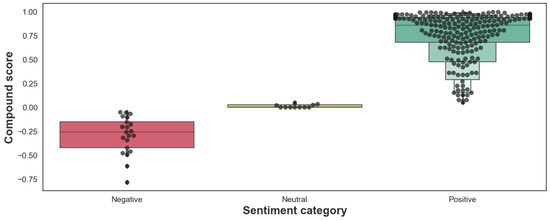
Figure 1.
Compound score distribution assessment.
However, positive reviews dominate the data set, with 213 reviews. These opinions have a high average score of 0.770, reflecting a definite enthusiasm. The dispersion of points in this category is significant, showing a diversity in the intensity of positive reviews, ranging from moderately to highly favorable. Overall, the reviews were very positive, despite adverse reactions and a few neutral reviews (Table 1).

Table 1.
Descriptive statistics for review sentiment scores.
3.2.2. Topic Modeling Using Non-Negative Matrix Factorization
In the study of sentiment analysis, non-negative matrix factorization (NMF) plays a crucial role. This method decomposes a matrix of textual data into two matrices with non-negative elements, thus revealing latent themes in a corpus evaluated as positive, negative, or neutral with VADER.
NMF is recognized for its ability to automatically discover topics in large volumes of text [78]. It has been successfully applied in unstructured text [79,80]. A notable advantage of NMF is the reduction in the number of parameters required in modeling despite its optimization objective being a nonconvex problem [81]. Finally, NMF stands out for its ability to simultaneously perform dimension reduction and clustering, facilitating the creation of topic-specific models for unstructured documents [82]. It is an unsupervised learning method for finding meaningful and physically interpretable latent variable decompositions [83]. In the context of sentiment analysis, the NMF method is central to identifying latent themes in our text corpus, using the formula:
Here, V is the original textual data matrix used to decompose, while W and H are the resulting matrices containing the corresponding non-negative basis vectors and coefficients, respectively. This decomposition minimizes the reconstruction error between V and WH [68,84]. For a better understanding, Kuang et al. [85] were able to conceptualize the NMF decomposition of a matrix composed of m words in n documents into two non-negative matrices of the original n words by k subjects and those same k subjects by the original m documents (Figure 2).
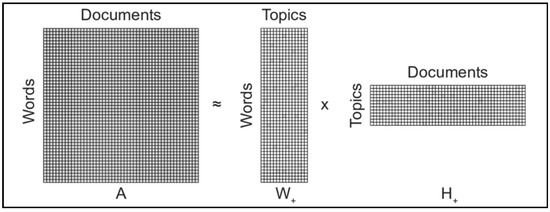
Figure 2.
Topic discovery of non-negative matrix factorization by Kuang et al. [77].
4. Results
4.1. Illustration of Exploratory Data Analysis
The highest number of reviews was recorded between 2016 and 2017. During the COVID-19 period, however, the number decreased, then increased in 2022 and grew the following year in parallel with the recovery of tourism (Figure 3).
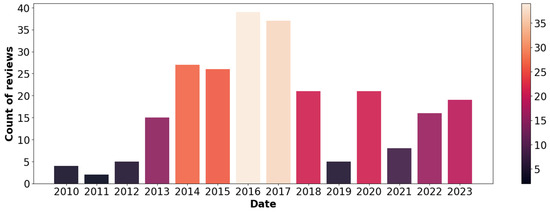
Figure 3.
Count of reviews over time. Note: The color scale on the right of the bar chart identifies each hue corresponding to the specific number of comments associated with each bar, representing a given year.
A qualitative analysis of the visitors’ feedback on the Hegra archaeological site, rated on TripAdvisor, reveals a predominantly positive assessment. Indeed, a tiny proportion of reviews, just eight, classify the experience as “Very Bad”. This downward trend continues, with four reviews grading the experience as “Bad”, underlining the low incidence of dissatisfaction among visitors.
On the other hand, a slightly higher number of people, 11, rated their experience as “Average”, indicating neutral satisfaction, which could reflect an expectation of additional qualities or services. However, perceptions improve considerably, with 47 visitors describing their visit as “Very Good”, testifying to a positive and enriching experience. This appreciation is even more evident in the “Excellent” category, which accounts for most reviews, with 175 highly positive returns. These glowing reviews underline the excellence of the Hegra archaeological site, suggesting that the vast majority of visitors leave with memorable impressions and a high regard for the place (Figure 4).

Figure 4.
Count of reviews by rating.
The analysis of tourist reviews on the archaeological site of Hegra reveals intriguing patterns related to the length of comments based on the ratings given (Figure 5).
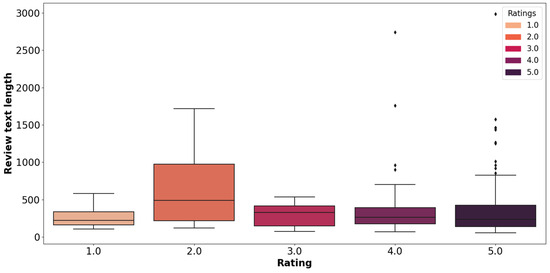
Figure 5.
Distribution of review text length by rating.
Analyzing the feedback in detail, it emerges that reviews categorized as “Very Poor” are relatively brief, averaging 267 characters, suggesting that dissatisfied visitors tend to express their discontent succinctly. On the other hand, “Poor” reviews are significantly longer, averaging 702 characters, which might indicate a tendency to provide detailed explanations about the negative aspects of their experience.
Furthermore, “Average” ratings present a moderate average length of 287 characters, striking a balance between expressing satisfaction and reservation. Surprisingly, in the “Very Good” category, wide variability in review length has been observed, with some comments being extremely detailed, as evidenced by the maximum of 2742 characters. This reveals that some visitors are particularly eager to share their positive experiences.
Finally, although “Excellent” reviews are the most numerous, they display an intermediate average length of 345 characters. However, this category also includes pervasive narratives, up to 2988 characters, underscoring that the most satisfied visitors sometimes take the time to narrate their memorable visit in detail. The outliers observed for the higher ratings confirm this trend towards exhaustive accounts when the experience is wildly appreciated.
This analysis demonstrates that, while the general trend indicates that negative reviews are longer, notable exceptions in the positive categories reveal a desire to share enriching experiences equally detailed (Table 2).

Table 2.
Descriptive statistics for review sentiment scores.
Looking at the data processing, a 14.69% rate of missing values for visitor nationality emerges. Despite this limitation, the overall understanding of the audience remains intact, highlighting the predominance of local visitors from Saudi Arabia (33.49%). Although the country promotes international cultural tourism, data demonstrate that the most relevant part of the visitors (quantitatively) is represented by local (domestic) as Saudi citizens or foreign permanent resident citizens (Figure 6).
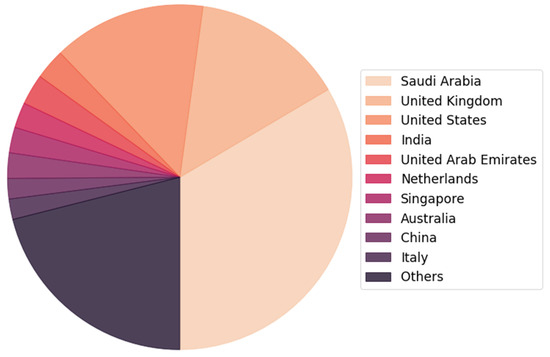
Figure 6.
Visitor nationalities of Hegra site (2010–2023).
The most frequent bigrams and their dendrogrammatic co-occurrence matrix (Figure A2 in Appendix B) eloquently demonstrate that “Hegra” is the scene of a remarkable interconnection between the bigrams “Al Ula” and “Saudi Arabia”, with 55 occurrences for pairs involving “Al Ula” and 44 for those associated with Saudi Arabia. This data illustrates the perception of Hegra visitors as an indispensable pillar of its geographical and cultural environment. Hegra’s global stature as a heritage is underscored by the substantial frequencies of the terms “World Heritage” (32 occurrences), “Archaeological Site” (21 occurrences), and “Heritage Site” (17 occurrences), reflecting a valuation of its cultural and historical importance on a global scale. On another note, our analysis highlights an enthusiasm for history and archaeology, illustrated by the repeated presence of the term “Nabatean Kingdom” 13 times, thus revealing that the educational dimensions of the visit are highly esteemed. The association of Hegra with “UNESCO World” (19 occurrences) and the reciprocal mentions between “World Heritage”, “Heritage Site”, and “UNESCO World” highlight the recognition of the importance of preservation and a dedication to sustainability.
Furthermore, the most frequent trigrams and their dendrogrammatic co-occurrence matrix (Figure A3 in Appendix B) outline specific details of visit perceptions at these historical sites, focusing mainly on world heritage status and pre-Islamic history. The trigrams “world heritage site” and “UNESCO world heritage”, each mentioned 11 times, emphasize the importance of the site’s international recognition and its esteem among visitors. The series of trigrams referring to “pre-Islamic archaeological site”, appearing four times each, testify to a marked interest in the ancestral history of the region, including the imprint of Lihyanite and Roman occupations, Nabatean rule, and the ensuing historical chronology. These references illustrate a valuation of the complex layers of the site’s pre-Islamic history and its archaeological significance. Mentions of “archaeological site located” and “site located alula” (four occurrences each), as well as “al madinah region” and “madinah region saudi” (four occurrences each), underscore that the specific location of the site in the Al Madinah region in Saudi Arabia significantly contributes to its tourist appeal.
4.2. Mapping Topics by Their Sentiment Category
Considering the diversity of topics revealed over the years in the different categories of sentiments, our analysis has revealed recurring subjects that highlight the central trend of the perception of a “sense of place” over time. These constant topics throughout the periods have been meticulously identified and presented in Table 3, Table 4 and Table 5.

Table 3.
Central topics in negative reviews.

Table 4.
Central topics in neutral reviews.

Table 5.
Central topics in positive reviews.
These tables provide a summary of these themes, enriched by the reviews of visitors as tangible examples, classified according to the various categories of sentiments. Each table is adorned with the key terms of the subjects and their respective scores, obtained through the topic modeling approach as illustrated in Figure 7, Figure 8 and Figure 9.
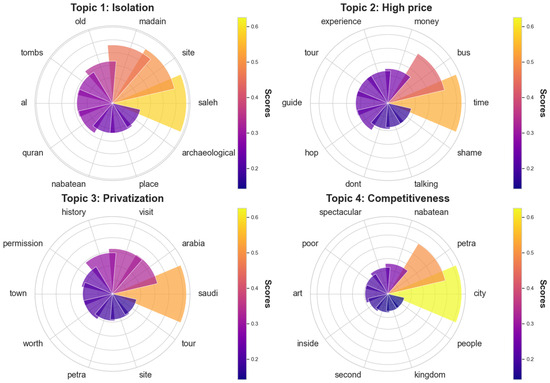
Figure 7.
Topic modeling for negative reviews.
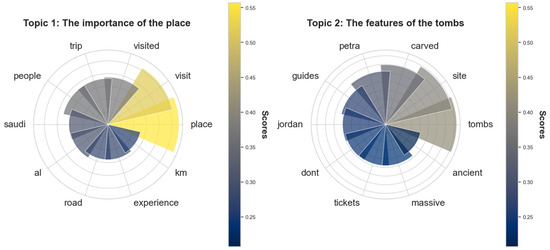
Figure 8.
Topic modeling for neutral reviews.
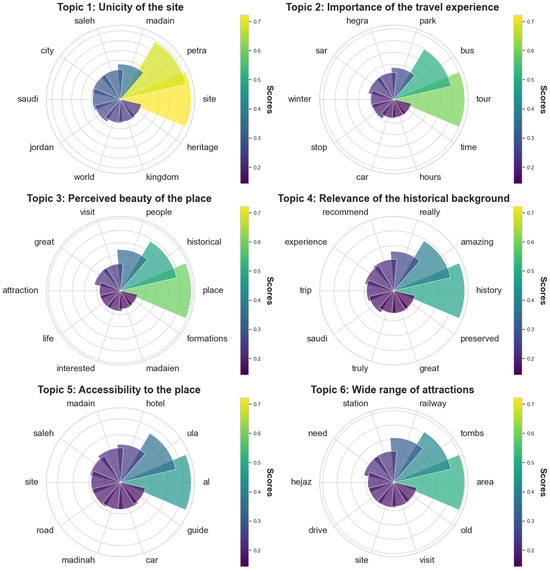
Figure 9.
Topic modeling for positive reviews.
Four main themes emerge from the analysis of the keywords. The first is linked to the site’s isolation; it is not easy to access from other tourist sites due to its distance. A second theme concerns the ticket price, which is considered high compared to the service. The penultimate element involves privatizing cultural heritage as an additional element that does not guarantee equity access to public cultural heritage. Finally, the last particularly significant theme concerns competitiveness, mainly when a close correlation with Petra is evident, of which the ability to manage cultural heritage and tourist flows is highlighted (Table 3).
Two main themes emerge from the analysis of the keywords. Neutral reviews, as the term suggests, are less penetrating. They mainly have a descriptive character and are centered on two major themes: the site, perceived as of great importance (also due to its registration as a UNESCO heritage site), and the tombs, due to their monumentality and beauty. In these reviews, however, a critical approach does not emerge, that is, a personal opinion of the user on the site visited (Table 4).
Six main themes emerge from the analysis of the keywords. The first is linked to the site’s uniqueness, often compared to Petra for historical reasons and, above all, for an extreme similarity of the funerary complexes. A second theme deals with the importance of the travel experience in terms of organization, particularly appreciated in a completely isolated site. Subsequently, a theme related to the place’s perceived beauty and historical importance emerges, promoting a sense of connection with the past. The penultimate theme concerns accessibility from a logistical point of view, i.e., easy access through an efficient road network and historical, following ancient restored caravan routes, which give prestige to the place and value to the experience. Finally, the last particularly significant theme concerns the wide range of attractions, such as the Elephant Rock and the tombs, considered holistic complexes that characterize and emphasize the visit to an archaeological site of cultural interest (Table 5).
5. Discussion
Using the VADER tool for sentiment analysis reveals a pronounced dominance of positive reactions among visitor reviews. This observation is reinforced by the average scores assigned: an average score of 0.769 for positive feedback, indicating an exceptionally high level of satisfaction and appreciation among most visitors. In contrast, negative comments, with an average score of −0.290, are less common and express modest negativity, signaling those dissatisfaction elements are not severely detrimental overall. As for neutral evaluations, displaying an average score close to zero (0.012), they are rare and demonstrate almost absolute neutrality, indicating incredibly nuanced and measured perceptions.
TripAdvisor is an online platform that tends to be hypercentric, that is, hyperpositive or hypernegative; however, it is possible to make some valuable considerations for the tourism development of the archaeological site. One of the most significant aspects that emerge from the overall analysis of the reviews is the exceptional nature of Hegra, perceived as a “magical” place due to its history and uniqueness. These two strengths are the ones in which to invest for the promotion of the site because, on the one hand, its historical value represents the economic lever for its marketing promotion as a brand; on the other, its uniqueness makes it sustainable as a niche destination and not for mass consumption, contained tourist flows without losing the sense of exclusivity. However, there are some more challenging aspects that, if appropriately managed, can improve the tourist experience and, consequently, the promotion of the destination.
One of the main challenges the site faces is related to its isolation. For example, while Petra (Jordan) is approximately two hours away from major tourist centers, the distance increases significantly in the case of Hegra. It implies the need to develop a hotel project based on the target of travelers interested in the site, i.e., those with a high cultural level, sensitive to elegance but not pomp.
A second challenge to consider is related to the cost of the visit, which in many cases is perceived as high. However, similar cases exist: for example, the price of Gorilla Tracking (Rwanda), an exploratory tour to see gorillas in their natural habitat, costs 1500 per person with one year of prebooking [86] precisely to guarantee a more sustainable management of the park and better control of tourist flows. At the same time, this also implies adopting policies tailored to the target type. For example, in Machu Pichu (Peru), the visit cost includes a reduction for undergraduate students and minors between 3 and 17 years old. In comparison, it offers free entry to children from 0 to 3 years old [87]. Similarly, at the Kakum National Park (Ghana), there are reductions for Ghanaian citizens compared to non-Ghanaians, recognizing the cultural heritage belonging to the local community [88]. But, in addition to defining the terms of access, even the visit methods should also be considered through the adoption of codes of conduct, as in the case of the Arizona State Park (USA), which has adopted an “Archaeological Site Etiquette” on how to behave in the presence of artifacts, rock piles, rock art, etc. [89].
A third element of analysis concerns the privatization process. Unfortunately, the public administration is not always able to manage all the cultural heritage of a country, so the PPC (Public-Private Cooperation) represents a facilitator in the management process, as in the case of the Colosseum (Italy), whose ticket office is entrusted to a private company [90]. However, a good outcome of this allocation process also depends on the policy adopted by the government through discussion with the social partners and on the type of agreement between the parties to avoid monopoly and exclusivity of use by the private sector and having the public good as a common objective.
A fourth element concerns the competitiveness, sometimes unfavorable, of Hegra compared to Petra. However, promoting a tourist destination, such as an archaeological site, aims not to impose itself on another but to emerge among all through a network that enhances the site’s uniqueness. For example, the archaeological site of Pompeii (Italy), which linked its fame to the violent volcanic eruption that destroyed the Roman city, has also included other Roman sites in the same area in its circuit [91], reducing the pressure of tourists within the site and promoting other places of cultural interest, which are linked to its brand.
Finally, two significant concerns emerged in the neutral aspects. On the one hand, the site’s significance reflects a pragmatic approach adopted by visitors, who share their impressions after the visit to enrich the visiting intention of potential future visitors. On the other hand, the attributes of the tomb prove to be a fascinating element, with visitors recounting the history and origins of the site. This narrative highlights the cultural and historical depth of the site, underlining its importance beyond its mere archaeological aesthetics.
6. Conclusions
6.1. Tourism Development in Hegra UNESCO Site
Recognized as a UNESCO World Heritage site, Hegra’s precious pre-Islamic past and cultural significance attract archaeology and history enthusiasts. Its rich history, marked by the influence of the Lihyanites, Romans, and Nabateans, gives it exceptional archaeological and educational value.
As a result of our study, the precise identification of aspects requiring urgent improvement and those that are particularly appreciated paves the way for an in-depth reflection process for Hegra site managers. They can holistically understand visitors’ needs and expectations by looking closely at these aspects. This understanding encourages revising management strategies in the light of evaluation feedback, engaging managers in an iterative continuous improvement process. This enables them to dynamically adapt the overall experience offered to visitors and remain competitive in the heritage tourism market.
So, despite the limitation due to the platform’s hypercentrism, the analysis helps obtain valuable data on the cultural heritage’s strengths and, at the same time, highlights the weaknesses for which measures can be adopted to contain or solve the single problems that emerged, such as developing tourism to promote the heritage site as a travel destination.
In fact, it is believed that any place, as well as landscapes and monuments, can transfer emotions and sensations to those who visit them, those who stop there, and anyone who meets them. It is evident that contemporary analytical research can only reconstruct through the artificial adaptive systems the fragments of this communication [92] by recording, quantifying, and also qualifying the visitor’s suggestions, but what results is one of the potential “sense” of that place, and today this potential sense/meaning is in the actual form of our collective memory, the digital and interconnected memory. To plan a sustainable enhancement of Hegra, grasping the perceived sense of this spectacular place is necessary. Still, at the same time, we must not forget that every enhancement and tourism promotion project is, first and foremost, an educational project for the enjoyment of heritage. At the center of this educational project must be placed the inhabitants of the area, their education, and their basic needs. The construction of a proposal that stands between the sense that tourists perceive of Hegra and the socioeconomic needs of the local population will help to increase the attractiveness of the site not only as a natural visit destination but as a place inhabited by many different cultures played a crucial geopolitical role in the history of the ancient Near East as well in the actual process of decolonization [93].
6.2. Methodological and Managerial Implications
Deploying sentiment analysis using the VADER tool and a topic modeling NMF approach on tourist reviews on TripAdvisor has brought several contributions, particularly in methodological and managerial aspects.
Regarding methodological implications, it is essential to highlight that combining VADER and NMF methods allowed us to gain a more comprehensive perspective. As mentioned earlier, the VADER tool enabled us to understand the general sentiments of the visitors. At the same time, the NMF helped us to discover the most impactful and discussed topics in the visitors’ reviews, thus providing more in-depth and contextualized subjective and objective insights. Regarding managerial contributions, the results offer broader insights into “what can/should be done” for decision-makers in the UNESCO World Heritage sites, namely Hegra. These include capturing transparent information for decision support, improving ex-post and ex-ante visitor satisfaction processes, personalizing tourism perception, optimizing online reputation, and, more broadly, enhancing Saudi Arabia’s heritage appeal through this original vector, the “archaeological heritage site” object.
6.3. Recommendations and Outlook for Improvement
Negative aspects are often related to each other. For instance, a high price might indicate that visitors do not perceive the value of their visit on a psychological level as sufficient, which underscores the need to justify the cost with added value. To this end, creating facilities such as an archaeological or ethnographic museum, several museums, dining and gastronomy offerings, or even a small shopping center for souvenirs could enrich the experience.
A virtual reality experience could be an innovative solution for visitors facing logistical challenges. By developing a virtual tour application, each participant could receive a souvenir from Saudi Arabia at home after paying for their virtual journey. It would enhance the site’s uniqueness and help promote it to a broader audience.
Moreover, training staff to provide a warm welcome, guide visitors efficiently during their visit, and speak various languages can significantly improve the visitor experience. By meeting visitors’ specific needs and enhancing their overall experience, these measures can help overcome criticism and make the site unique and memorable.
6.4. Research Limitations
Although our study has valuable implications, it reveals certain limitations that must be considered in future academic contributions.
Right from the start, let us tackle the technical complexity of identifying fraudulent reviews on TripAdvisor. This obstacle remains, even when the volume of comments analyzed remains manageable, as illustrated by our investigation. Linguistically, our choice to focus solely on English reviews significantly restricts our research scope. A sentimental study embracing multiple languages proves crucial to accurately grasp the cultural diversity of Jardin Majorelle’s visitors and its global influence. For a better understanding, it is essential to examine the concept of a “sense of place” for Hegra, which should be diversified, including other social networks and the place’s official website. Adopting this approach would offer an enriched perspective on how this site is perceived by its audience.
Author Contributions
Conceptualization, S.S.; methodology, A.S. and L.S.; software, A.S. and L.S.; validation, A.M.-P.; formal analysis, S.S.; resources, F.M.d.C.C.; data curation, A.S. and L.S.; writing—original draft preparation, S.S.; writing—review and editing, F.M.d.C.C. and M.R.; visualization, A.S. and L.S.; supervision, A.M.-P. and M.R. All authors have read and agreed to the published version of the manuscript.
Funding
This research received no external funding.
Data Availability Statement
The study presents its original contributions within the published article. For further information, please contact the corresponding authors.
Conflicts of Interest
The authors declare no conflicts of interest.
Appendix A
Located in northwest Saudi Arabia, Hegra, also known as Madā’in Sālih, was a crucial city on the southern boundary of the Nabatean empire. This city played a central role as an essential stop on the caravan route, facilitating trade between South Arabia and the shores of the Mediterranean via Petra, the heart of the Nabatean empire. The boundaries of the Nabatean kingdom at its peak, stretching from the north near Damascus to Hegra in the south, with Petra at its core, reveal the territorial extent achieved by this kingdom around the first century BCE.
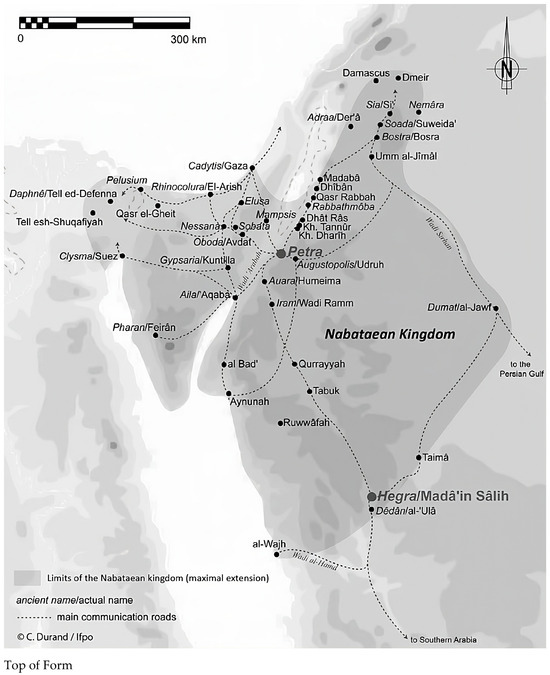
Figure A1.
Map of the Nabataean kingdom illustrating the geographical location of the Hegra archaeological site in Saudi Arabia according to Durand and Gerber [94].
Appendix B
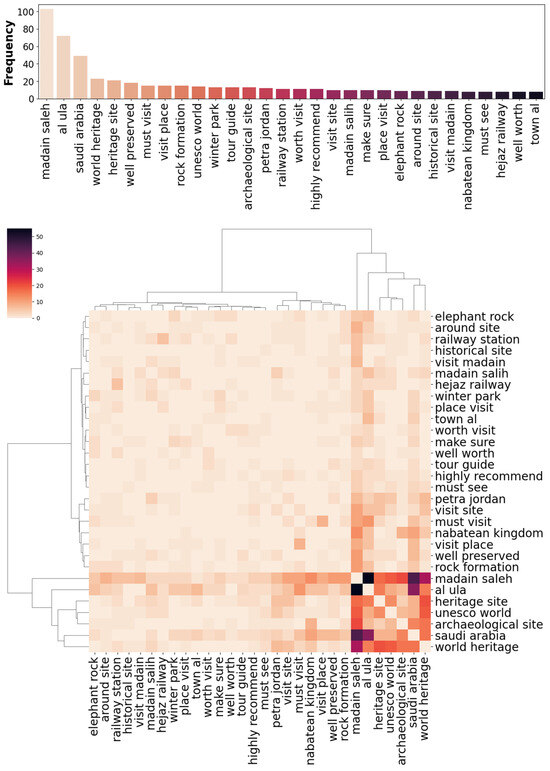
Figure A2.
Top 30 most frequent bigrams and their dendrogrammatic co-occurrence matrix.
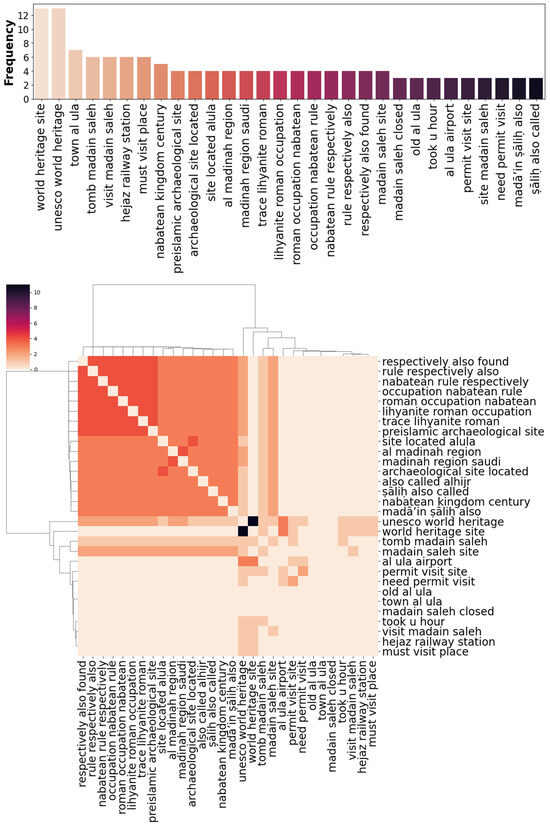
Figure A3.
Top 30 most frequent trigrams and their dendrogrammatic co-occurrence matrix.
References
- Al-Tokhais, A.; Thapa, B. Management issues and challenges of UNESCO World Heritage Sites in Saudi Arabia. J. Herit. Tour. 2020, 15, 103–110. [Google Scholar] [CrossRef]
- Fili, M.; Križaj, D. Electronic Word of Mouth and Its Credibility in Tourism: The Case of Tripadvisor. Acad. Tur.-Tour. Innov. J. 2017, 9, 107–111. Available online: https://academica.turistica.si/index.php/AT-TIJ/article/view/64 (accessed on 15 April 2024).
- Becken, S.; Alaei, A.R.; Wang, Y. Benefits and pitfalls of using tweets to assess destination sentiment. J. Hosp. Tour. Technol. 2020, 11, 19–34. [Google Scholar] [CrossRef]
- Stedman, R.C. Is It Really Just a Social Construction?: The Contribution of the Physical Environment to Sense of Place. Soc. Nat. Resour. 2023, 16, 671–685. [Google Scholar] [CrossRef]
- Hutto, C.; Gilbert, E. VADER: A Parsimonious Rule-Based Model for Sentiment Analysis of Social Media Text. In Proceedings of the International AAAI Conference on Web and Social Media, Ann Arbor, MI, USA, 1–4 June 2014; Volume 8, pp. 216–225. [Google Scholar]
- Wang, S.; Deng, C.; Lin, W.; Huang, G.B.; Zhao, B. NMF-Based Image Quality Assessment Using Extreme Learning Machine. IEEE Trans. Cybern. 2017, 47, 232–243. [Google Scholar] [CrossRef] [PubMed]
- Tuan, Y. Topophilia; Prentice Hall: Bergen, NJ, USA, 1974; ISBN 9780231073950. [Google Scholar]
- UNESCO. Convention Concerning the Protection of the World Cultural and Natural Heritage; UNESCO: Paris, France, 1972. [Google Scholar]
- Dewi, C.; Rofe, M.; Nichols, J. Heritage and the COVID-19 pandemic: The meaning of visitation. Built Herit. 2023, 7, 11. [Google Scholar] [CrossRef]
- Li, Y.; Stoffelen, A.; Meijles, E.; Vanclay, F. Local people’s sense of place in heavily touristified protected areas: Contested place meanings around the Wulingyuan World Heritage Site, China. Landsc. Urban Plan. 2023, 237, 104792. [Google Scholar] [CrossRef]
- Pepe, L.; Schmitz, S. The Sense of Place of Local Mining Heritage in Wallonia. Herit. Soc. 2023, 1–33. [Google Scholar] [CrossRef]
- Marghany, M.; Morgan, N.; Finniear, J.; White, P. Heritage hotels: An exploration of staff experiences in these unique hospitality environments. Tour. Hosp. Res. 2023. [Google Scholar] [CrossRef]
- Wei, H.; Yu, Y.; Yuan, Z. Heritage Tourism and Nation-Building: Politics of the Production of Chinese National Identity at the Mausoleum of Yellow Emperor. Sustainability 2022, 14, 8798. [Google Scholar] [CrossRef]
- Moscatelli, M. Cultural identity of places through a sustainable design approach of cultural buildings. The case of Riyadh. In Proceedings of the International Conference on Sustainability: Developments and Innovations, ICSDI, Riyadh, Saudi Arabia, 19–22 February 2022; IOP Conference Series: Earth and Environmental Science. IOP Publishing: Bristol, UK, 2022; Volume 1026. [Google Scholar] [CrossRef]
- Xiang, T.H.; Mohamed, D. The effect of placemaking attributes on tourism experience: A case of study of petaling street in Malaysia. Plan. Malays. 2023, 21, 322–333. [Google Scholar] [CrossRef]
- Korani, Z.; Sam, F. A comparative study of heritage visitors’ perceptions of time in the modern era. Curr. Issues Tour. 2023, 26, 807–822. [Google Scholar] [CrossRef]
- Bresler, M. Specifics of perception of historical and cultural heritage by generation Z in the conditions of network existence. In Proceedings of the International Scientific Conference Ecological and Biological Well-Being of Flora and Fauna, Blagoveschensk, Russia, 22–25 May 2023; Volume 420. [Google Scholar] [CrossRef]
- Zhou, K.; Wu, W.; Li, T. Exploring visitors’ visual perception along the spatial sequence in temple heritage spaces by quantitative GIS methods: A case study of the Daming Temple, Yangzhou City, China. Built Herit. 2023, 7, 24. [Google Scholar] [CrossRef]
- Dabphet, S. Examining the role of heritage-destination attributes on travel constraints and revisit intention using multilevel analysis. J. Hosp. Tour. Insights 2023. [Google Scholar] [CrossRef]
- Coscia, C.; Pasquino, F. Demand Analysis Models to Support Cultural Tourism Strategy: Application of Conjoint Analysis in North Sardinia (Italy). Land 2023, 12, 2150. [Google Scholar] [CrossRef]
- Mohanty, R.N.; Mohanta, A. Assessment of stakeholders’ perspectives on infill buildings in the historical settings of an eastern India state—Odisha. J. Cult. Herit. Manag. Sustain. Dev. 2023. [Google Scholar] [CrossRef]
- Chen, G.; Shi, J.; Xia, Y.; Furuya, K. The Sustainable Development of Urban Cultural Heritage Gardens Based on Tourists’ Perception: A Case Study of Tokyo’s Cultural Heritage Gardens. Sustainability 2020, 12, 6315. [Google Scholar] [CrossRef]
- Katahenggam, N. Tourist perceptions and preferences of authenticity in heritage tourism: Visual comparative study of George Town and Singapore. J. Tour. Cult. Change 2020, 18, 371–385. [Google Scholar] [CrossRef]
- Yang, H.; Qiu, L.; Fu, X. Toward Cultural Heritage Sustainability through Participatory Planning Based on Investigation of the Value Perceptions and Preservation Attitudes: Qing Mu Chuan, China. Sustainability 2021, 13, 1171. [Google Scholar] [CrossRef]
- Nayan, N.M.; Jones, D.S.; Ahmad, S.; Khamis, M.K. Exploring the built-environment: Heritage trails, values and perceptions. In Proceedings of the IOP Conference Series: Earth and Environmental Science, Banda Aceh, Indonesia, 15–16 September 2021; IOP Conference Series: Earth and Environmental Science. IOP Publishing: Bristol, UK, 2021; Volume 881. [Google Scholar] [CrossRef]
- François Lecompte, A.; Trelohan, M.; Gentric, M.; Aquilina, M. Putting sense of place at the centre of place brand development. J. Mark. Manag. 2017, 33, 400–420. [Google Scholar]
- Smith, S. Un sentido de lugar: Lugar, cultura y turismo. Investig. Sobre Recreación Turística 2015, 40, 220–233. [Google Scholar] [CrossRef]
- Wang, J.; Zhou, Z.; Lei, T.; Sun, J.; Zhang, H.; Qian, L. Tourists’ sense of place and heritage protection when visiting natural disaster memorials. J. Destin. Mark. Manag. 2024, 32, 100875. [Google Scholar] [CrossRef]
- Marzo, M.; Ferrario, V. Between Sense of Time and Sense of Place Designing, Heritage, Tourism; LetteraVentidue: Siracusa, Italy, 2022; ISBN 9788862426732. [Google Scholar]
- Bowman, N.D.; Lee, Y.; Chen, S.; Vandewalle, A.; Daneels, R. Animating a Plausible Past: Perceived Realism and Sense of Place Influence Entertainment of and Tourism Intentions From Historical Video Games. Games Cult. 2023, 19, 286–308. [Google Scholar] [CrossRef]
- Rodríguez-Fernández, M.M.; Sánchez-Amboage, E.; Juanatey-Boga, O. Virtual tourist communities and online travel communities. Commun. Innov. Qual. 2019, 154, 435–446. [Google Scholar] [CrossRef]
- Carrasco-Santos, M.J.; Ciruela-Lorenzo, A.M.; Pavón, J.G.M.; Rodríguez, C.C. An online reputation analysis of the tourism industry in Marbella: A preliminary study on open innovation. J. Open Innov. Technol. Mark. Complex. 2021, 7, 111. [Google Scholar] [CrossRef]
- O’Connor, P. Managing a hotel’s image on TripAdvisor. J. Hosp. Mark. Manag. 2010, 19, 754–772. [Google Scholar] [CrossRef]
- Marine-Roig, E.; Clavé, S.A. Affective component of the destination image: A computerised analysis. In Destination Marketing; Pile, S., Ed.; Routledge: London, UK, 2015; pp. 49–58. ISBN 9781315720050. [Google Scholar]
- Buhalis, D.; Sinarta, Y. Real-time co-creation and nowness service: Lessons from tourism and hospitality. J. Travel Tour. Mark. 2019, 36, 563–582. [Google Scholar] [CrossRef]
- Lam, J.M.; Ismail, H.; Lee, S. From desktop to destination: User-generated content platforms, co-created online experiences, destination image and satisfaction. J. Destin. Mark. Manag. 2020, 18, 100490. [Google Scholar] [CrossRef]
- Paige-Lovingood, M. In the Shadow of the Queen: On UNESCO’s Universal History, the Women of the Petit Trianon, and Tourist Meaning-Making. Int. Public Hist. 2021, 4, 127–137. [Google Scholar] [CrossRef]
- Pereira, T.; Lima, F.B.C.; Leoti, A. Tourism management and planning at a UNESCO heritage site: A study of the Ruins of the Jesuit Mission of São Miguel das Missões, Brazil [Gestão e planejamento turístico de um patrimônio mundial da UNESCO: Um estudo sobre as Ruínas da Missão Jesuítica de São Miguel das Missões, Brasil]. PASOS Rev. Tur. Patrim. Cult. 2022, 20, 285–298. [Google Scholar]
- Nguyen, T.H.; Ağbay, N.C.; Çakar, K. Visitors’ experiences of UNESCO World Heritage Site: Evidence from Göbeklitepe, Türkiye. J. Hosp. Tour. Insights 2023. [Google Scholar] [CrossRef]
- Sánchez, F.T. Comparison of Memorable Tourist Experiences Based on Collections of Reviews from Trip Advisor: Acropolis of Athens and Royal Alcazar of Seville. In Proceedings of the 8th International Conference of the International Association of Cultural and Digital Tourism, Hydra, Greece, 1–3 September 2022; Transcending Borders in Tourism through Innovation and Cultural Heritage. Springer: Berlin/Heidelberg, Germany, 2022; pp. 943–960. [Google Scholar] [CrossRef]
- Baniya, R.; Dogru-Dastan, H.; Thapa, B. Visitors’ experience at Angkor Wat, Cambodia: Evidence from sentiment and topic analysis. J. Herit. Tour. 2021, 16, 632–1645. [Google Scholar] [CrossRef]
- Tan, C.L.; Yeo, S.F. Tourist experience on traditional pastries in UNESCO heritage city. Br. Food J. 2020, 122, 3885–3897. [Google Scholar] [CrossRef]
- Stoleriu, O.M.; Brochado, A.; Rusu, A.; Lupu, C. Analyses of Visitors’ Experiences in a Natural World Heritage Site Based on TripAdvisor Reviews. Visit. Stud. 2019, 22, 192–212. [Google Scholar] [CrossRef]
- Magalhães, M.; Braga, J.L.; Borges, I. Improve the Traveler’s Experience: Model to Improve the Traveler Experience. In Advances in Tourism, Technology and Systems; Carvalho, J.V., Rocha, A., Liberato, P., Peña, A., Eds.; Springer: Berlin/Heidelberg, Germany, 2023. [Google Scholar] [CrossRef]
- Hassan, M.A.E.; Zerva, K.; Aulet, S. A Model for Brand Personality Word Embedding: Identifying UNESCO World Heritage Personality Categories. J. Travel Res. 2024, 63, 44–63. [Google Scholar] [CrossRef]
- Šormaz, A.; Ruoss, E. Social Media as a Management Tool: Opportunities for Sustainable Heritage Destinations. Acad. Tur. 2023, 16, 121–138. [Google Scholar] [CrossRef]
- Hassan, M.A.E.; Zerva, K.; Aulet, S. Brand Personality Traits of World Heritage Sites: Text Mining Approach. Sustainability 2021, 13, 6142. [Google Scholar] [CrossRef]
- Koufodontis, N.I.; Gaki, E. UNESCO urban world heritage sites: Tourists’ awareness in the era of social media. Cities 2022, 127, 103744. [Google Scholar] [CrossRef]
- Peira, G.; Beltramo, R.; Pairotti, M.B.; Bonadonna, A. Foodservice in a UNESCO Site: The Restaurateurs’ Perception on Communication and Promotion Tools. Sustainability 2018, 10, 2911. [Google Scholar] [CrossRef]
- Rastegar, R.; Zarezadeh, Z. Millennials and social media marketing: The case of Indian UNESCO world cultural heritage sites. In Millennials, Spirituality and Tourism; Sandeep, K.W., Jasrotia, A., Eds.; Routledge: London, UK, 2022; pp. 157–178. ISBN 9781003170631. [Google Scholar]
- Konstantakis, M.; Christodoulou, Y.; Alexandridis, G.; Teneketzis, A.; Caridakis, G. ACUX Typology: A Harmonisation of Cultural-Visitor Typologies for Multi-Profile Classification. Digital 2022, 2, 365–378. [Google Scholar] [CrossRef]
- Olorunsola, V.O.; Saydam, M.B.; Lasisi, T.T.; Ozturen, A. Exploring tourists’ experiences when visiting Petra archaeological heritage site: Voices from TripAdvisor. Consum. Behav. Tour. Hosp. 2023, 18, 81–96. [Google Scholar] [CrossRef]
- Rohmer, J.; Charloux, G. From Liḥyān to the Nabataeans: Dating the end of the Iron Age in north-west Arabia. In Proceedings of the Seminar for Arabian Studies; Archeopress: Oxford, UK, 2014; Volume 45, pp. 297–319. ISBN 9781784911454. [Google Scholar]
- Al-Ansary, A. The State of Lihyan: A New Perspective. Topoi 1999, 9, 191–195. [Google Scholar] [CrossRef]
- Nehmé, L. Explorations récentes et nouvelles pistes de recherche dans l’ancienne Hégra des Nabatéens, moderne Al-Hijr/Madāi’ n Sālih (Arabie du Nord-Ouest). Comptes Rendus Séances L’académie Inscr. Belles Lett. 2004, 148, 631–682. [Google Scholar] [CrossRef]
- Fiema, Z.T.; Villeneuve, F.; Bauzou, T. New Latin and Greek Inscriptions from Ancient Hegra. Z. Papyrol. Epigr. 2020, 214, 179–202. [Google Scholar]
- Charloux, G.; Bouchaud, C.; Durand, C.; Garber, Y.; Studer, J. Living in Madāʾin Ṣāliḥ/Hegra during the late pre-Islamic period. The excavations of Area 1 in the ancient city. In Proceedings of the Seminar for Arabian Studies, London, UK, 4–6 August 2017; Archeopress: Oxford, UK, 2017; Volume 48, pp. 47–65, ISBN 1784918776. [Google Scholar]
- UNESCO. Hegra Archaeological Site. 2024. Available online: https://whc.unesco.org/en/list/1293/ (accessed on 14 January 2024).
- Villeneuve, F.; Al-Talhi, D.; Nehmé, L. Résultats préliminaires de la première campagne de fouille à Madâ’in Sâlih en Arabie Saoudite. Comptes Rendus Séances L’académie Inscr. Belles-Lett. 2008, 152, 651–691. [Google Scholar] [CrossRef]
- Oxford Archaeology. Al Ula Archaeological Landscape Survey. 2018. Available online: https://www.oxfordarchaeology.com/news/alula-archaeological-landscape-survey (accessed on 16 January 2023).
- Kingdom of Saudi Arabia. Saudi Vision 2030. 2024. Available online: https://www.vision2030.gov.sa/v2030/overview/ (accessed on 15 January 2024).
- Alrawaibah, A. Archaeological Site Management in the Kingdom of Saudi Arabia: Protection or Isolation? In Cultural Heritage in the Arabian Peninsula; Exell, K., Rico, T., Eds.; Routledge: London, UK, 2016; pp. 143–156. ISBN 9781315575285. [Google Scholar]
- Alqahtany, A.; Aravindakshan, S. Urbanization in Saudi Arabia and sustainability challenges of cities and heritage sites: Heuristical insights. J. Cult. Herit. Manag. Sustain. Dev. 2022, 12, 408–425. [Google Scholar] [CrossRef]
- Manning, C.D.; Raghavan, P.; Schütze, H. Boolean retrieval. In Introduction to Information Retrieval; Cambridge University Press: Cambridge, UK, 2008; pp. 1–18. ISBN 0521865719. [Google Scholar]
- Tripathy, A.; Agrawal, A.; Rath, S.K. Classification of sentiment reviews using n-gram machine learning approach. Expert Syst. Appl. 2016, 57, 117–126. [Google Scholar] [CrossRef]
- Scott, J. Social network analysis: Developments, advances, and prospects. Soc. Netw. Anal. Min. 2011, 1, 21–26. [Google Scholar] [CrossRef]
- Murtagh, F.; Legendre, P. Ward’s hierarchical agglomerative clustering method: Which algorithms implement Ward’s criterion? J. Classif. 2014, 31, 274–295. [Google Scholar] [CrossRef]
- Lee, A.; Willcox, B. Minkowski generalizations of Ward’s method in hierarchical clustering. J. Classif. 2014, 31, 194–218. [Google Scholar] [CrossRef]
- Kapil, S.; Chawla, M. Performance evaluation of K-means clustering algorithm with various distance metrics. In Proceedings of the 2016 IEEE 1st International Conference on Power Electronics, Intelligent Control and Energy Systems (ICPEICES), Delhi, India, 4–6 July 2016; pp. 1–4. [Google Scholar] [CrossRef]
- Liu, B.; Zhang, L. A survey of opinion mining and sentiment analysis. In Mining Text Data; Aggarwal, C.C., Zhai, C.X., Eds.; Springer: Berlin/Heidelberg, Germany, 2012; pp. 415–463. ISBN 978-1-4614-3222-7. [Google Scholar]
- Tang, D.; Wei, F.; Qin, B.; Yang, N.; Liu, T.; Zhou, M. Sentiment embeddings with applications to sentiment analysis. IEEE Trans. Knowl. Data Eng. 2015, 28, 496–509. [Google Scholar] [CrossRef]
- Kirilenko, A.P.; Stepchenkova, S.O.; Kim, H.; Li, X. Automated sentiment analysis in tourism: Comparison of approaches. J. Travel Res. 2018, 57, 1012–1025. [Google Scholar] [CrossRef]
- Liu, S.M.; Chen, J.H. A multi-label classification based approach for sentiment classification. Expert Syst. Appl. 2015, 42, 1083–1093. [Google Scholar] [CrossRef]
- Borg, A.; Boldt, M. Using VADER sentiment and SVM for predicting customer response sentiment. Expert Syst. Appl. 2020, 162, 113746. [Google Scholar] [CrossRef]
- Bonta, V.; Kumaresh, N.; Janardhan, N. A comprehensive study on lexicon based approaches for sentiment analysis. Asian J. Comput. Sci. Technol. 2019, 8, 1–6. [Google Scholar] [CrossRef]
- Hutto, C.J. vaderSentiment/vaderSentiment/vader_lexicon.txt, GitHub. 22 May 2020. Available online: https://github.com/cjhutto/vaderSentiment/blob/master/vaderSentiment/vader_lexicon.txt (accessed on 24 July 2020).
- Pano, T.; Kashef, R. A complete VADER-based sentiment analysis of bitcoin (BTC) tweets during the era of COVID-19. Big Data Cogn. Comput. 2020, 4, 33. [Google Scholar] [CrossRef]
- Qiang, J.; Li, Y.; Yuan, Y.; Liu, W. Snapshot ensembles of non-negative matrix factorization for stability of topic modeling. Appl. Intell. 2018, 48, 3963–3975. [Google Scholar] [CrossRef]
- Arora, S.; Ge, R.; Moitra, A. Learning topic model—Going Beyond SVD. In Proceedings of the 2012 IEEE 53rd Annual Symposium on Foundations of Computer Science, New Brunswick, NJ, USA, 20–23 October 2012; pp. 1–10. [Google Scholar] [CrossRef]
- Kuang, D.; Choo, J.; Park, H. Nonnegative matrix factorization for interactive topic modeling and document clustering. In Partitional Clustering Algorithms; Springer: Cham, Switzerland, 2015; pp. 215–243. [Google Scholar]
- Lee, D.D.; Seung, H.S. Learning the parts of objects by non-negative matrix factorization. Nature 1999, 401, 788–791. [Google Scholar] [CrossRef] [PubMed]
- Xu, Q.; Zhu, L.; Dai, T.; Guo, L.; Cao, S. Non-negative matrix factorization for implicit aspect identification. J. Ambient. Intell. Humaniz. Comput. 2020, 11, 2683–2699. [Google Scholar] [CrossRef]
- Schmidt, M.N.; Winther, O.; Hansen, L.K. Bayesian non-negative matrix factorization. In Proceedings of the Independent Component Analysis and Signal Separation: 8th International Conference, ICA 2009, Paraty, Brazil, 15–18 March 2009; pp. 540–547. [Google Scholar] [CrossRef]
- Paatero, P. Least squares formulation of robust non-negative factor analysis. Chemom. Intell. Lab. Syst. 1997, 37, 23–35. [Google Scholar] [CrossRef]
- Kuang, D.; Brantingham, P.J.; Bertozzi, A.L. Crime topic modeling. Crime Sci. 2017, 6, 12. [Google Scholar] [CrossRef]
- Visit Rwanda. Gorilla Tracking. 2024. Available online: https://www.visitrwanda.com/interests/gorilla-tracking/#:~:text=Book%20Your%20Gorilla%20Tracking%20Experience&text=Cost%20US%20%241500%20per%20person,and%20East%20African%20Community%20residents (accessed on 15 January 2024).
- Machu Pichu. Reservas. 2024. Available online: https://reservas.machupicchu.gob.pe/inicio (accessed on 15 January 2024).
- Visit Ghana. Kakun National Park. 2024. Available online: https://visitghana.com/attractions/kakum-national-park/ (accessed on 15 January 2024).
- Arizona State Park. Archeological Site Etiquette. 2024. Available online: https://azstateparks.com/archaeological-site-etiquette (accessed on 15 January 2024).
- Parco Archeologico del Colosseo. Parco Archeologico del Colosseo, Firmato il Contratto con il Nuovo Gestore Della Biglietteria. 2024. Available online: https://colosseo.it/2023/11/colosseo-nuovo-gestore-biglietteria/ (accessed on 15 January 2024).
- Pompei. Crcuito Archeologico Vesuviano. 2024. Available online: https://www.ticketone.it/artist/circuito-archeologico-pompei/ (accessed on 15 January 2024).
- Ramazzotti, M. Analytical Archaeology and Artificial Adaptive Systems. In ARCHEOSEMA Artificial Adaptive Systems for the Analysis of Complex Phenomena; Ramazzotti, M., Ed.; Collected Papers in Honour of David Leonard Clarke, Archeologia e Calcolatori, Supplemento 6; All’Insegna del Giglio: Firenze, Italy, 2014; pp. 15–52. [Google Scholar]
- Ramazzotti, M. Costeggiando l’Eurasia. Relitti e rotte della navigazione tra il Mar Inferiore (Oceano Indiano) e il Mar Superiore (Mediterraneo orientale). Vicino Oriente 2021, 25, 81–104. [Google Scholar] [CrossRef] [PubMed]
- Durand, C.; Gerber, Y. The pottery production from Hegra/Madāʾin Sālih (Saudi Arabia) during the Nabataean period. Preliminary results, 2008–2011. In Proceedings of the Seminar for Arabian Studies; Archaeopress: Oxford, UK, 2014; ISBN 190573980X. [Google Scholar]
Disclaimer/Publisher’s Note: The statements, opinions and data contained in all publications are solely those of the individual author(s) and contributor(s) and not of MDPI and/or the editor(s). MDPI and/or the editor(s) disclaim responsibility for any injury to people or property resulting from any ideas, methods, instructions or products referred to in the content. |
© 2024 by the authors. Licensee MDPI, Basel, Switzerland. This article is an open access article distributed under the terms and conditions of the Creative Commons Attribution (CC BY) license (https://creativecommons.org/licenses/by/4.0/).